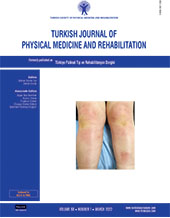Comparison of ankle force, mobility, flexibility, and plantar pressure values in athletes according to foot posture index
2 Department of Physiology, Eskişehir Osmangazi University, Faculty of Medicine, Eskişehir, Turkey
3 Eskisehir Technical University, Sports Science, Eskişehir, Turkey
4 University of Stuttgart, Modelling and Simulation, Stuttgart, Germany DOI : 10.5606/tftrd.2022.4904 Objectives: This study aims to compare ankle force, mobility, flexibility, and plantar pressure distribution of athletes according to foot posture index (FPI).
Patients and methods: Between September 2016 and May 2018, a total of 70 volunteer male athletes (mean age: 21.14±2.28 years; range, 18 to 25 years) were included. The athletes were divided into three groups according to their FPI as follows: having supinated feet (Group 1, n=16), neutral/normal feet (Group 2, n=36), or pronated feet (Group 3, n=18). Ankle range of motion (ROM), muscle flexibility, ankle joint strength, and plantar pressure distribution were measured.
Results: There were significant differences among the three groups in both right and left ankle dorsiflexion ROM (p=0.009 and p=0.003, respectively). Group 1 had significantly smaller dorsiflexion ROM than the other groups. Group 1 also showed significantly less flexibility in the gastrocnemius and soleus muscles than the other foot posture groups. Groups 2 and 3 exhibited significant differences in the maximum torque (p=0.018), maximum work (p=0.008), and total work (p=0.008) of the right plantar flexor muscles at 60°/sec angular velocity. Peak pressure measurements of the right foot were higher in Group 1, compared to Groups 2 and 3 (p<0.001).
Conclusion: The results of this study may help to enhance athletic performance by providing a guide for designing training programs appropriate for athletes with different foot types to address their specific muscle flexibility and strength deficiencies.
Keywords : Flexibility, foot posture index, plantar pressure, sport, strength

















